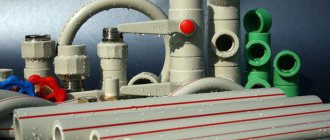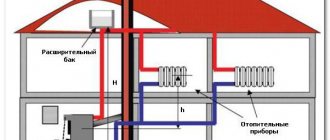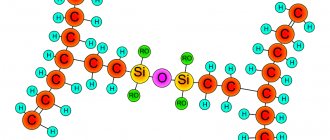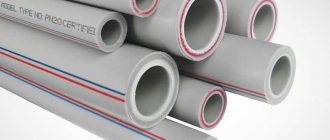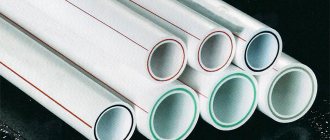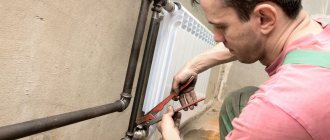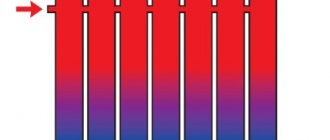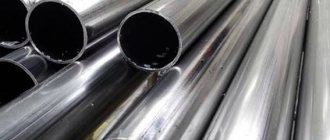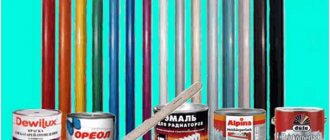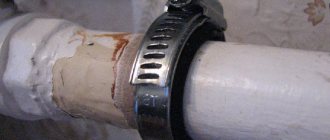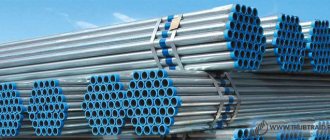- home
- Construction and renovation
- Plumbing
>
>
⬎
Polypropylene pipes and fittings are widely used by plumbers of various levels and home craftsmen. This is not surprising - installation does not require expensive equipment, all work is relatively simple to master. Currently, these pipes are used in water supply, both cold and hot water, and heating. Often risers in apartment buildings are made of polypropylene.
There are also quite a few opponents of this technology. There are reasons for this - various leaks in PPR pipes are far from uncommon, emergency services workers know about this phenomenon firsthand.
To be fair, it is worth noting that problems arise mainly due to non-compliance with installation technology and incorrect selection of the type of pipes. It is also worth noting low-quality pipes and components - due to the great popularity of polypropylene, it began to be manufactured in almost every basement.
In this material we will look at the correct choice of polypropylene pipes for a specific situation, soldering technology and other important aspects.
Types of polypropylene pipes
In this review we will consider PPR pipes for water supply and heating; various thin-walled, summer cottage options will not be considered. All pipes are divided into three main types, characterizing the reinforcing material. Different manufacturers may have additional layers, but in general, this does not change the main purpose of the material.
The data is based on VALTEC products; figures for other manufacturers may differ.
The first is polypropylene without a reinforcing layer
. It is used in cold water supply systems and has the highest coefficient of linear thermal expansion. And although the manufacturer claims compliance with service classes according to GOST 32415-2013 - 1, 2 (hot water supply 60°C, 70°C), in general, unreinforced pipes are recommended for use only in cold water supply (my personal opinion). In cold water, the pipe is capable of maintaining a guaranteed pressure of 20 bar; with hot water, the operating pressure decreases - 12 bar for a temperature of 60 °C and 8 bar for 70 °C. The numbers are valid for pipes marked PN20 (more on this below). This type of pipe is often produced with a lower operating pressure.
The pipes have a linear coefficient of thermal expansion of 0.00013/1°C. This means that when the pipe temperature increases by 1 degree Celsius, a 1 m long pipe will become 0.13 mm longer. Not much at first glance, however, if you use a pipe in a hot water supply of 70 °C and take into account cooling to 15 °C, the change in length over a three-meter segment will already be 21.45 mm. This is one of the reasons not to use these pipes in hot water supply.
The second is with a reinforcing layer of PP-FIBER fiberglass
. Used in hot water supply systems, they have a lower linear expansion coefficient. May be marked PN20 and PN25. These pipes can be safely used in hot water supply, up to a water temperature of 90 °C; the maximum permissible operating pressure at this temperature is reduced to 6 bar.
The coefficient of linear expansion is 0.000062/1°C - half that of unreinforced pipes. Despite the smaller expansion, it is not worth neglecting during installation.
The third type - with a reinforcing layer of aluminum PP-ALUX
. Used in hot water supply and heating systems, they are marked PN25. These pipes have the lowest coefficient of thermal expansion and greater resistance to pressure at high temperatures. Suitable for use with liquid temperatures up to 95 °C. In addition to pressure and temperature, the aluminum layer prevents oxygen diffusion. Diffusion of oxygen into pipes is a phenomenon undesirable for heating systems. This phenomenon will not be considered in more detail within the framework of this article.
Currently, pipes with external reinforcement that require stripping are, as a rule, a rarity. They have gained relevance with internal reinforcement in the middle of the pipe; they do not require stripping. They are also called “lazy ones”. However, this pipe requires trimming with a special tool to prevent water from contacting the aluminum!
The coefficient of linear expansion of 0.000031/1°C is two times less than that of fiberglass and four times less than that of unreinforced polypropylene. The data is valid for continuous reinforcement of pipes with aluminum, when stripping before soldering is not required.
Watch a video about aluminum reinforcement:
Polypropylene pipes PP-ALUX
Regardless of the type of reinforcement, all pipes are marked with a maximum operating pressure - PN15, PN20, PN25; this alphanumeric designation characterizes resistance to pressure in bars. For example: the PN20 marking says that the pipe can be operated at a pressure of 20 bar. Also, the marking indirectly indicates the maximum operating temperature, because unreinforced pipes above PN20 are not found (at least for now). By the way, there are also lower PN values, but their use is recommended in systems without pressure.
An older system for designating the working pressure of pipes - SDR - is the ratio of diameter to wall thickness; the lower this number, the thicker the pipe.
The thickest PN25 is equivalent to SDR6. If you look at the table, SDR is not always the same as PN. You need to focus primarily on PN and, if possible, choose a lower SDR. Table of permissible pressures and temperatures of various types of polypropylene pipes
| Reinforcement type | Class PN | SDR Ratio | Operating pressure | Application area |
| PPR 100 | PN20 | 6.0 | ХВ-20 bar 60 °C-12 bar 70 °C-8 bar | Cold water supply, use in hot water with a pressure not higher than 8(70°C), 12(60°C) bar is allowed |
| PP-FIBER | PN20 | 7.4 | ХВ-20 bar 60 °C-13 bar 70 °C-10 bar 90 °C-6 bar | HW, HW, underfloor heating 70 °C, radiator heating 90 °C |
| PP-FIBER | PN25 | 7.4 | ХВ-25 bar 60 °C-14 bar 70 °C-11 bar 90 °C-9 bar | HW, HW, underfloor heating 70 °C, radiator heating 90 °C |
| PP-ALUX | PN25 | 6.0 | ХВ-25 bar 60 °C-14 bar 70 °C-11 bar 95 °C-9 bar | HW, HW, underfloor heating 70 °C, radiator heating 95 °C |
*Data given for VALTEC pipes.
How to choose polypropylene pipes
When choosing polypropylene pipes for hot water or process pipelines, it is necessary to take into account the performance characteristics and recommended operating conditions. Manufacturers indicate basic data about their products in the labeling - diameter, pressure. Colored longitudinal lines not only simplify alignment, but also indicate whether the product can or cannot be used in hot or cold water pipelines.
Design features
Manufacturers produce single-layer and multi-layer pipes from polypropylene copolymers. When using PPR 100, single-layer products are characterized by high strength characteristics and are able to withstand pressure of 10-15PN for a long time. The disadvantage of the design is the increased linear expansion. The advantage is simple installation using inexpensive tools.
Three-layer pipes have an outer and inner layer of PPR, which ensures corrosion resistance, resistance to aggressive chemicals, and low emission of organics into the external environment. The middle layer is a fiberglass composite or aluminum alloy foil. This structure ensures low linear expansion under the influence of heat, which simplifies the installation and operation of pipelines.
Marking
On the outer surface there is a marking containing basic information about the product. The inscriptions contain letters and numbers. The product is marked in the following order:
- The material from which the product is made is indicated - PP (polypropylene) and its modification: R - random, H - homopolymer, B - block copolymer;
- The outer diameter is recorded in millimeters;
- The operating pressure PN is indicated.
Application of different types of pipes in practice
Despite the data given in the table above, it is worth clearly distinguishing the scope of application of each type of pipe. This is not the absolute truth, this is my humble opinion. And although the manufacturer allows the use of their pipes almost everywhere, I look at things with a realistic look. After all, you need to have a good margin of strength and temperature, as in Soviet times, in order to be confident in the quality of the work performed. So…
Polypropylene for water supply
Any of the pipes described in the table above are suitable for cold water supply. For hot water, I strongly recommend using polypropylene with reinforcement, both fiberglass and aluminum. I generally refrain from using unreinforced products, even for cold water. After all, the cost of pipes with reinforcement is not much more expensive.
Polypropylene for heating a private house
All characteristics are suitable for pipes of all types of reinforcement. The pressure and temperature in your own, individual system are low and you don’t have to worry about a pipe breaking. However, it is better to look towards PN25 fiberglass or aluminum.
For heating a private home, a PPR pipe is perhaps the best solution. Lower cost of installation, which you can do yourself, as well as make changes to the system later - along with these advantages, the pipes are highly reliable.
Polypropylene for central heating
In accordance with GOST 32415-2013, the fifth class of operation of plastic pipes can withstand a temperature of 80°C for a long time. To be more precise, the minimum service life must be at least 10 years. The same regulatory document states that already at a temperature of 90°C the service life is reduced to 1 year (minimum). And the new pipe will withstand even a coolant temperature of 100°C, but this is an emergency mode and lasts only 100 hours.
Read more about the characteristics of polypropylene pipes and their markings.
Of course, a pipe manufacturer can make products that exceed GOST standards in terms of their characteristics. However, it is more likely that, due to the human factor, the quality will be even slightly worse than the stated requirements.
It follows from this that for reliable operation of plastic pipes in central heating systems, it is necessary to maintain the coolant temperature within the specified limits. In houses where polypropylene pipes are provided for by the design, there are no problems with this. In houses where metal heating pipes are installed by default, as a rule, no special measures are taken to limit the temperature. Installation of PP pipes can only be done at your own peril and risk!
Of course, you can be flexible in your thinking and use plastic in those places where the coolant passes through many apartments and cools down before reaching the intended installation site. As an example: a single-pipe “Leningrad” with supply from above or through the riser of the next room, and the replacement installation is located on the lower floors - the temperature of the coolant in such areas drops significantly. However, whatever one may say, this is an amateur activity, for which the installer bears responsibility.
Laying pipes on the street
One of the features of PPR pipes is that when water freezes in it, the pipe does not burst, but expands. When the water thaws, the pipe returns to its original state. I myself have witnessed this phenomenon many times. Moreover, frozen water pipes are very difficult to break by mechanical force, this is subject to a quality choice.
Polypropylene is perfect for laying pipes in a personal plot or country house. You couldn't imagine better material!
DIY heating installation
You can install the heating system yourself. The main thing is to choose the right materials, compare them correctly and seal them tightly. The design itself is quite simple to assemble and operate.
What connectors to use
In order to attach one pipe to another, pipes to risers and radiators, pressure gauges and other devices, special connectors are needed. The following types are distinguished:
- Straight (regular couplings). They are necessary in those places where one pipe connects to another of the same diameter, but not at an angle;
- Curved. Used in places where the system bends and rotates;
- Triples. They are needed if you need to make two from one pipe or one from two. For example, in the places where branches extend from the main pipe to the radiator;
- Blind (stubs). They are installed in “dead-end” areas, for example, on the outer radiators;
- With a change in the internal section. They are used when moving from a larger diameter pipe to a smaller diameter pipe. For example, when connecting pipes with risers;
- With plastic and metal. Such connectors are necessary in places where there is a transition from plastic products (pipes) to metal ones (radiators, pressure gauges, tanks).
Before starting installation work, it is necessary to recreate on paper the exact diagram of the proposed system and calculate the number of connectors of each type. In addition, it is important to select connectors whose internal diameters will coincide with the diameters of the pipes.
We recommend that you read: Installation of PVC pipes for hot and cold adhesive joints
Installation work algorithm
After drawing up a heating scheme and purchasing all the necessary elements, you can begin installation work.
To do this, you will need a special kit consisting of a soldering iron with attachments (couplings and drones) and shaders.
It is not necessary to purchase it to install one heating system; it can be rented.
It is important! When carrying out work for the first time, it is recommended to buy more parts than necessary. After improper welding, the disconnected parts are no longer suitable for use, so you will have to take new ones.
The installation algorithm looks like this:
- Cutting pipes and laying out connectors. This is a preparatory stage that is important to perform strictly according to the instructions. The pipe is cut using special scissors.
- Cleaning pipes with a shaver. This step is only necessary when installing pipes with aluminum reinforcement. To do this, take a shaver and put it on the pipe, and rotate it manually or with a screwdriver.
- Soldering iron assembly. Couplings and mandrels of the appropriate diameter are put on the apparatus, after which it is turned on and heated to 260 ͒ C. At this time, a depth mark is made on the pipe corresponding to the connecting element.
- Compound. A pipe is inserted into the coupling of a heated soldering iron to a certain depth, and a connecting element is inserted into the mandrel on the other side, after which the elements are soldered to each other over a certain period of time. The time is calculated as follows: with a pipe diameter of 1.6 cm - 5 seconds, 2.0 cm - 7 seconds, 3.2 cm - 8 seconds.
- All other sections of the pipe are assembled in a similar way, after which the structure is connected to the heating system.
Pipe diameters
Standard diameters of polypropylene pipes: 20 mm, 25 mm, 32 mm, 40 mm and more... The standards use the outer diameter, while the inner (useful) diameter depends on the SDR ratio. Very conditionally, they are considered equivalent to metal pipes: 16 mm metal (1/2) - 20 mm propylene, 20 mm metal (3/4) - 25 mm propylene, 25 mm metal (inch) - 32 polypropylene. 32 metal (inch and 1/2) - 40 mm polypropylene.
I called the equivalents very conditional due to the fact that for metal pipes the internal diameter is taken into account as a standard, while for PPR the external diameter is taken into account. For example: a metal pipe “1” (inch) has an internal diameter of 25 mm, an equivalent polypropylene 32 mm has an internal diameter of about 21 mm (depending on the SDR parameter). In other words, if we use 32 mm polypropylene to replace a 25 mm (inch) metal pipe, then the effective internal diameter will become narrower. This should be taken into account when there is absolutely no need to narrow the diameters of the pipes.
In connection with what was written, I compiled the following table:
Table of standard diameters of metal and polypropylene pipes
| Steel water pipe GOST 3262-75 | Polypropylene pipe, useful equivalent | |||
| Thread diameter in inches (nominal size*) | Inner diameter, mm | Outer diameter, mm | Outer diameter, mm | Inner diameter(SDR 6.0), mm |
| «1/4» | 8 | 13,5 | — | — |
| «3/8» | 10 | 17 | 20 | 13,2 |
| «1/2» | 15 | 21,3 | 25 | 16,6 |
| «3/4» | 20 | 26,8 | 32 | 21,2 |
| «1» | 25 | 33,5 | 40 | 26,6 |
| «1 1/4» | 32 | 42,3 | 50 | 33,4 |
| «1 1/2» | 40 | 48 | 63 | 42 |
*Some dimensions in inches do not match the numbers in millimeters, so the clearance is conditional. In order not to be misled, it is worth taking these numbers for granted.
As we can see from the table, for example, half-inch 1/2 pipes are replaced without narrowing by 25 PPR, and not by 20, as is customary in most cases. This means that it is not at all necessary to change 1/2-inch iron pipes to 25 polypropylene; it is quite possible to get by with a size of 20 mm. But you should understand that the useful diameter will narrow. And if you consider that thinner pipes can be used in the water supply system, SDR 7.4, for example, then the internal diameter will almost not narrow.
Marking of multilayer pipes
This group has a complex naming system
| Marking | Indication of the type of reinforcement |
| PPR-AL-PPR | Aluminium foil |
| PP-RCT-AL-PPR | Modified polypropylene, aluminum foil, polymer outer layer. |
| PPR-FB-PPR | Fiberglass layer on the inside. |
| PPR-FB-PPR, PPR/PPR-GF/PPR | Composite material: fiberglass + polypropylene. |
| PP-RCT+BF | Basalt layer |
Pipe fittings (couplings)
Fittings for polypropylene pipes are more often called couplings. Couplings are either collapsible or non-dismountable. Based on my experience, I recommend using non-separable ones; fewer components means higher reliability.
It is recommended to use couplings and pipes from the same manufacturer, but this is not a necessary condition. Since the outer diameters of all pipes are fixed standard, couplings from other manufacturers will fit without problems. However, it is worth remembering that the manufacturer declines all responsibility for pipe leaks if components from other companies were used.
.
An important point in choosing couplings is compliance with the permissible pressures with the pipes. If a PN25 pipe is used, then the coupling must have the corresponding designation. Very often, sellers in specialized plumbing stores do not indicate this fact and sell PN20 couplings for a PN25 pipe.
It is worth adding that it is better to try to take high-quality fittings from global brands. The fact is that in a good fitting, at the junction of the metal and polypropylene, there is an O-ring. It is possible to see this ring only by sawing the coupling lengthwise.
What does this ring do? Not so often, but it does happen that when the coupling is of poor quality, water is forced between the iron and the plastic. You can’t call it a leak; it usually squeezes out a few drops in ten to twenty minutes and after a few hours the leak becomes clogged. But sometimes the leak does not stop the next day, so the unit has to be replaced. And considering that the soldering point is disposable, replacement can bring a lot of hassle. In general, do not skimp on couplings and fittings!
Watch a video about combined polypropylene fittings:
Combined couplings for polypropylene pipes
Features of PPR pipes
Main advantages:
- Long service life.
- Low price.
- Absence of corrosion processes typical of metals.
- The smooth inner surface allows for increased fluid pressure.
- Quiet transport of water or other liquids.
- Easy to perform installation work.
- It is possible to install taps without using threaded connections using soldering equipment.
- There is no need for periodic maintenance of pipe and butt joint blocks. This allows you to install it under the floor or under the plaster finishing layer and forget it for a long period.
Along with the positive qualities and features, we must not forget about some disadvantages when choosing polypropylene pipes. The pipes have low ductility and bend poorly, which does not allow for corner wiring. Intermediate couplings of the appropriate profile are required, bent at the angle at which the pipeline needs to be rotated. If damage to the material occurs during installation, the product will have to be thrown away and replaced with a new one. If a defect occurs, the structure can no longer be repaired. The entire section of assembled pipes will have to be cut out and reinstalled. For installation work, you need special pipe cutting scissors and soldering equipment.
Some of the problems are eliminated thanks to the packaging: a large number of auxiliary parts - fittings and couplings - makes it possible to assemble and create structures from pipes of various configurations, up to the most complex ones.
Polypropylene taps
When using plastic pipes, it will be more aesthetically pleasing to use taps coated with polypropylene. This is usually what inexperienced plumbers think about. In fact, it is better to use regular brass taps with a transition to polypropylene through a coupling.
At first glance, a faucet filled with a polypropylene shell seems to be the ideal solution. Does not spoil the overall appearance of the plastic pipeline, does not require additional parts for connection to a common unit.
The fact is that taps filled with plastic have lower reliability. The faucet consists of two fundamentally different materials (metal and plastic), with different densities and thermal expansions. Due to different properties, problems often arise in the form of leaks or breakdowns. Global manufacturers recognize the shortcomings of polypropylene cranes and are working on the mistakes, but it is too early to say with complete confidence about reliable cranes of this type.
A much more reliable solution would be a brass tap with two threaded couplings. The coupling also contains two materials, metal and plastic, but these parts are stationary, unlike a tap.
In addition to reliability, there is also an aesthetic side to using conventional taps: the tap can be rotated along its axis and given a more even position. The sealed plastic tap cannot be turned on the pipe; you need to do the soldering very clearly the first time; the soldering can only be corrected by soldering in a new tap.
In fact, brass faucets provide more options. They can be replaced without soldering, if the faucet comes with an American one; the connection is detachable in case of other repairs. American becomes relevant when installed in hard-to-reach places.
In addition, conventional cranes are, as a rule, smaller in size, and the range of products is much wider.
Just like brass, polypropylene taps come in two types: valve and ball. Please note that ball valves can only be used in two positions: open and closed, adjustment is not allowed.
All manufacturers say so. However, on this score, in the process of working as a plumber, a different opinion was formed...
The above is true for expensive, high-quality products, but in our realities, as a rule, we have to deal with budget faucets. So, if we compare two budget products, a valve and a ball valve, the ball wins in terms of reliability, even with constant adjustment. Although the valve is specifically designed for regulation, it fails very quickly. This opinion has been formed over many years of work. These considerations are valid both for brass shut-off and control valves, and for products filled with polypropylene.
And finally, I would like to say: you should not skimp on taps, as well as on all plumbing fixtures. Pipes and all components should be purchased from reliable stores; this should be done slowly and thoughtfully!
Selection of pipes for water supply
Polypropylene piping components are a practical and relatively inexpensive option for installing water pipes in homes.
To supply cold water, a simple version of polypropylene pipes without special layers that strengthen the element is suitable. These are inexpensive single-layer pipes without reinforcement. Feel free to choose them.
RPH single-layer pipe made of solid homopropylene, durable, can withstand heating up to 60 degrees C, higher temperatures are not recommended
PPV single-layer pipe made of flexible block copolymer, resistant to defrosting.
PPR single-layer random copolymer pipe, more durable and resistant to temperature rise, recovers after defrosting.
They differ in diameter - from 20 to 40 mm, and shell thickness - from 1.9 to 6.7 mm. The shell thickness is indicated by the parameter PN10 or PN20. These parameters affect the hydrodynamic properties of the system and the throughput of the water supply system. Pipes ⌀ 32 mm are connected to the central water supply; for internal communications, ⌀ 16 - 25 mm are sufficient.
To supply hot water, it is possible to choose the connection of single-layer inexpensive polypropylene pipes:
- PPR, PPRC from a copolymer of propylene and ethylene - coolant temperature less than 70 degrees C
- PPS – made of special polypropylene – heating no more than 95°C
However, for greater reliability it is worth using reinforced pipes. Experts recommend pipes reinforced with fiberglass:
PPR-FB-PPR – propylene sandwiched with fiberglass fiber
PPR/PPR-GF/PPR – three-layer pipe, inside and outside made of polypropylene, the middle layer is made of a composite material in which glass fiber is distributed in a polypropylene matrix. A colored intermediate layer on a light background is a distinctive external feature of these pipes.
They are produced, for example, by the Italian-Chinese company Valtec and the Russian company Kontur. They are superior to aluminum-coated options in a number of characteristics; they are easier to install, do not need to be cleaned during assembly, and do not swell during operation or collapse from the inside.
Meanwhile, aluminum pipes are impermeable or almost impermeable to oxygen. This is an important property, since oxygen, saturating the coolant water with bubbles, creates so-called cavitation processes in all metal components of the water supply system. They destroy the walls of pumps, valves and other parts.
About leaks, fistulas and other reviews about polypropylene
On professional construction forums, many horror stories are told about polypropylene leaks. The climax is a video where a man breaks pipes on a comb like dry rods. Any novice plumber or home craftsman will immediately disown this technology. What can I say, experienced craftsmen are confused by such arguments.
The reason for such defects, oddly enough, is savings on pipes and components. Currently, many products are sold from “basement” factories, for which technical descriptions cannot be found. Please note: if you decide to use a PP-ALUX pipe, for example, from a little-known manufacturer, the data in the pressure and temperature table above does not necessarily apply to your brand. No one exempts you from studying technical documentation from a specific pipe manufacturer.
It follows from this that many “plumbers” do not bother studying the characteristics of pipes. And this can lead to errors in soldering and installation. By the way, despite the simplicity of the technology, it must be performed with due care, observing the soldering temperature and other nuances. I have seen a lot of pipes soldered by “shabashniks” - in the vast majority of cases, the soldering was done with overheating, the pipe was incorrectly selected for a specific task.
I had to dismantle a lot of plastic pipes and I didn’t come across the horror stories described on the Internet. The pipes, after 5-10 years of operation, were in excellent condition; no cracks or destruction of the material were observed from the inside. Most often, the places where the leak occurred were poorly soldered connections, despite the fact that a properly soldered connection is much more reliable than the pipe itself. In simple terms, it’s hard for me to imagine such “hand-assed” installers. Nevertheless, there are a lot of such installers - they showed the technology, and simply said - this is the end of the worker’s qualifications. Hence all the ensuing consequences and problems, as well as the tarnished reputation of polypropylene.
This piece of pipe is cut from the hot water supply system of an apartment building. According to the customer, the pipes stood for about ten years, the date of manufacture indirectly confirms this. There were no problems, the alteration was carried out to install meters. The cut shows no changes in the thickness of the polypropylene; there is a coffee-colored coating on the inner walls, which can be easily wiped off with a finger. The pipe from Ecoplastic is Czech polypropylene without reinforcement.
Also, polypropylene owes its tarnished reputation to marketers who are actively promoting cross-linked polyethylene
. By the way, cross-linked polyethylene is not as resistant to high temperatures as it seems from beautiful stories. The job of marketers is to emphasize the advantages and gloss over the shortcomings of their product, and comment on the opposite about the competitor’s product. Everything is simple, just study the technical documentation for both products and everything will fall into place.
We will look at soldering polypropylene separately, but that’s all for now. And once again, I strongly recommend that you carefully select all materials for rough plumbing, beware of fakes and approach the issue thoroughly.
See also: Tips for welding polypropylene pipes and fittings
Rate this publication:
- Currently 3.81
Rating: 3.8 (43 votes)
Types of PPR pipes
Products vary in layering factor. Main groups:
Single-layer pipes are widespread, this is due to their low price. At the same time, they cannot be used for pipelines with high heating temperatures. If the liquid is heated above 70 degrees Celsius, significant linear elongation of such products occurs. Single-layer polypropylene pipes can have different chemical compositions and use different polymers. The type of chemical compound determines the performance properties of the product. Therefore, you should always take a closer look at the markings of pipes in order to understand for what purposes they should be used. How single-layer pipes are marked:
| Marking | Name | Description | Areas of use |
| RRN | Homopolymer | Hard material. · Low resistance to low temperatures. | · Transportation of cold and hot water. · Production pipelines. |
| RRV | Block copolymer | Flexible material. | Cold water supply. |
| PPR | Statistical copolymer | Durable material. Withstands simultaneous short rises in temperature up to +110 degrees. WITH. Restores after defrosting. Resistant to aggressive environments. Good soundproofing properties. | Transportation of cold and hot water. Heating in an individual house. |
| P.P.S. | Special polymer |
Multilayer pipes, otherwise called reinforced. Reinforcement is an option to increase the load-bearing capacity of a product by using additional layers of materials; they strengthen the product and prevent the walls from excessively expanding and lengthening.
Reinforcement of PPR pipes to reduce elongation is of two types:
The metal in polypropylene pipes is an excellent material that increases strength. Ways to work with it:
- Adhesive application of a strip layer of foil on the outside of the pipe, which is overlapped or butted.
- External application of perforated metal sheet.
- Lining the interior with a layer of foil also with glue.
- Welding AL sheet at the joint to create a sealed space inside the pipe.
- Fiberglass reinforcement. It is located on the inside of the pipe; composite material can also be used - with the addition of polypropylene. The material increases resistance to high temperatures and reduces costs during assembly work.
- Reinforcement with basalt fiber. This is a relatively new material on the market. It has a number of advantages over existing options. It is believed to be more durable, resistant to pressure changes and high temperatures. The pipe capacity is higher with less weight. Basalt is an environmentally friendly material
Selection of heating pipes
The choice of heating system components is influenced by the same properties of polypropylene pipes, which are important for the supply of hot water. First of all, the quality of the polymer itself.
Inexpensive single-layer block copolymer PP pipes can be used in low-temperature heating systems
P.P.S. made of a special polymer without reinforcement are used for heating, provided that the temperature in the system is less than 95 degrees C
However, reinforced products for heating purposes are more reliable and acceptable.
PPR-AL-PPR – with an outer layer of aluminum film. PP-RCT-AL-PPR – a new type of propylene is used, sandwiched with aluminum with an external polymer coating.
PPR-FB-PPR – propylene layered with fiberglass fiber.
PPR/PPR-GF/PPR – three-layer, inside and outside made of polypropylene, the middle layer is made of a composite in which glass fiber is distributed in a polypropylene matrix.
PP-RCT + BF is a pipe with basalt fiber, characterized by low weight and good throughput.
Reinforced pipes are more expensive, but also more reliable; they are initially produced for coolants with a wide temperature range.
What are there and which are better?
According to their structure, polypropylene pipes come in three types:
- Single layer. The walls are completely made of polypropylene.
- Three-layer: fiberglass reinforced - fiberglass threads are sealed between two layers of polypropylene;
- reinforced with foil - the design is similar.
Now briefly about why polypropylene pipes are reinforced. The fact is that this material has a high coefficient of thermal expansion. When heated by 100°C, one meter of single-layer pipe becomes 150 mm longer. This is a lot, although no one will heat them that much, but even at lower temperature deltas the increase in length is no less impressive. To neutralize this phenomenon, compensation loops are installed, but this approach does not always save.
Types of expansion joints for polypropylene pipes
Manufacturers found another solution - they began to make multilayer pipes. They lay fiberglass or aluminum foil between two layers of pure propylene. These materials are not needed for strengthening or any other purposes, but only to reduce thermal elongation. If there is a layer of fiberglass, the thermal expansion is 4-5 times less, and with a layer of foil - 2 times. Compensation loops are still needed, but they are installed less frequently.
On the left is a fiberglass-reinforced pipe, on the right is a regular single-layer pipe
Why is reinforcement made with both fiberglass and foil? It's a matter of operating temperature range. Those with fiberglass can withstand heat up to 90°C. This is enough for hot water supply, but not always enough for heating. Polypropylene pipes reinforced with foil have a wider temperature range - they can withstand heating of the environment up to +95°C. This is already enough for most heating systems (except those with solid fuel boilers).
Which PPR pipes are suitable for which systems?
Based on everything said above, it is clear which polypropylene pipes are better for heating - those reinforced with foil, if high-temperature operation of the system is expected (from 70 ° C and above). For low-temperature heating systems, glass fiber reinforced products can be used.
Any PPR pipes are suitable for cold water supply, but the most rational solution is ordinary single-layer pipes. They cost quite a bit, and the thermal expansion in this case is not so great, one small expansion joint for the water supply in an average private house is enough, but in an apartment, with a small length of the system, they don’t make it at all, or rather they make an “L”-shaped one.
An example of a polypropylene water pipe
To install a hot water supply system, it is best to take polypropylene pipes with a fiberglass reinforcing layer. Their qualities are optimal here, but they can also be used with a foil layer. Please note that compensators are required.
Which ones are easier to install?
When deciding which polypropylene pipes are better, pay attention to such a parameter as the complexity of installation. All types are connected by welding, and for turns, branches, etc. fittings are used. The welding process itself is identical for all types, the difference is that in the presence of aluminum foil, pre-treatment is required - it is necessary to remove the foil to the soldering depth.
This is what the external reinforcement of a polypropylene pipe with foil looks like
In general, there are two types of aluminum reinforcement - external and internal. With the outer one, the foil layer is close to the outer edge (1-2 mm), with the inner one the reinforcing layer is located approximately in the middle. It turns out that it is filled with an almost identical layer of polypropylene on both sides. In this case, preparation for welding also consists of removing the outer layer of propylene to the entire depth of welding (and the foil too). Only under these conditions can the required seam strength be achieved. All this preparation takes a lot of time, but the most unpleasant thing is that if there is an error, we get a very unreliable connection. The most dangerous option is when water seeps into the foil. In this case, the polypropylene will sooner or later collapse and the connection will leak.
Foil-reinforced pipes must be welded correctly
Based on these data, we can come to the conclusion that if conditions permit, it is better to use single-layer or fiberglass-reinforced polypropylene pipes. Proponents of aluminum reinforcement say that foil further reduces the amount of air that penetrates into the system through the walls. But the foil is often made perforated and it does not necessarily go in a continuous strip, covering the entire diameter of the pipe. Often it has a longitudinal gap. After all, its task is to reduce the amount of thermal expansion, and even strips of more stable material can cope with this task.
